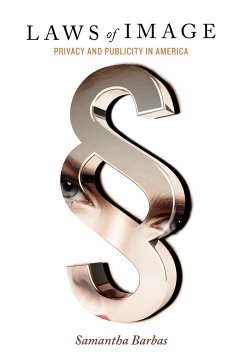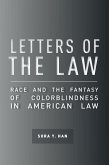Schade – dieser Artikel ist leider ausverkauft. Sobald wir wissen, ob und wann der Artikel wieder verfügbar ist, informieren wir Sie an dieser Stelle.
- Gebundenes Buch
- Merkliste
- Auf die Merkliste
- Bewerten Bewerten
- Teilen
- Produkt teilen
- Produkterinnerung
- Produkterinnerung
Samantha Barbas is Associate Professor of Law at SUNY Buffalo Law School. She is the author of two previous books: Movie Crazy: Fans, Stars, and the Cult of Celebrity (2001) and The First Lady of Hollywood: A Biography of Louella Parsons (2005).
Andere Kunden interessierten sich auch für
![The Law of Delict in Scotland The Law of Delict in Scotland]() Elspeth ReidThe Law of Delict in Scotland322,99 €
Elspeth ReidThe Law of Delict in Scotland322,99 €![Governing Bodies Governing Bodies]() Rachel Louise MoranGoverning Bodies59,99 €
Rachel Louise MoranGoverning Bodies59,99 €![Sports Image Rights in Europe Sports Image Rights in Europe]() Ian S. Blackshaw / Robert C. R. Siekmann (eds.)Sports Image Rights in Europe140,99 €
Ian S. Blackshaw / Robert C. R. Siekmann (eds.)Sports Image Rights in Europe140,99 €![Citizenship and the Origins of Women's History in the United States Citizenship and the Origins of Women's History in the United States]() Teresa Anne MurphyCitizenship and the Origins of Women's History in the United States53,99 €
Teresa Anne MurphyCitizenship and the Origins of Women's History in the United States53,99 €![Your Rugged Constitution Your Rugged Constitution]() Bruce Allyn FindlayYour Rugged Constitution18,99 €
Bruce Allyn FindlayYour Rugged Constitution18,99 €![The Failed Promise of Originalism The Failed Promise of Originalism]() Frank CrossThe Failed Promise of Originalism64,99 €
Frank CrossThe Failed Promise of Originalism64,99 €![Letters of the Law Letters of the Law]() Sora Y HanLetters of the Law122,99 €
Sora Y HanLetters of the Law122,99 €-
-
-
Samantha Barbas is Associate Professor of Law at SUNY Buffalo Law School. She is the author of two previous books: Movie Crazy: Fans, Stars, and the Cult of Celebrity (2001) and The First Lady of Hollywood: A Biography of Louella Parsons (2005).
Produktdetails
- Produktdetails
- Verlag: Stanford University Press
- Seitenzahl: 328
- Erscheinungstermin: 30. September 2015
- Englisch
- Abmessung: 231mm x 150mm x 25mm
- Gewicht: 612g
- ISBN-13: 9780804791441
- ISBN-10: 0804791449
- Artikelnr.: 42796451
- Herstellerkennzeichnung
- Libri GmbH
- Europaallee 1
- 36244 Bad Hersfeld
- gpsr@libri.de
- Verlag: Stanford University Press
- Seitenzahl: 328
- Erscheinungstermin: 30. September 2015
- Englisch
- Abmessung: 231mm x 150mm x 25mm
- Gewicht: 612g
- ISBN-13: 9780804791441
- ISBN-10: 0804791449
- Artikelnr.: 42796451
- Herstellerkennzeichnung
- Libri GmbH
- Europaallee 1
- 36244 Bad Hersfeld
- gpsr@libri.de
Samantha Barbas is Associate Professor of Law at SUNY Buffalo Law School. She is the author of two previous books: Movie Crazy: Fans, Stars, and the Cult of Celebrity (2001) and The First Lady of Hollywood: A Biography of Louella Parsons (2005).
Contents and Abstracts
1Image and Reputation
chapter abstract
The late 19th century saw the rise of the sensationalistic popular press in
the United States, and with it, the expansion of libel law and litigation.
In increasing number, both famous and ordinary people were bringing suit
against the press over false, defamatory, unflattering depictions. Once
seen as something to be negotiated through social interactions, in the
rough and tumble of everyday life, reputations and public images were
becoming legal entities, to be controlled and maintained through the use of
law and legal institutions.
2The Right to Privacy
chapter abstract
"The Right to Privacy" by Samuel Warren and Louis Brandeis, published in
the Harvard Law Review in 1890 and dubbed the "most famous law review
article of all time," established the practical and theoretical foundations
of the tort action for invasion of privacy. The privacy action permitted
people to sue over the mental anguish that ensued when they were depicted
before the public in an embarrassing or unfavorable manner, even though the
material was not necessarily false or defamatory. Like the surge in libel
litigation, the development of the right to privacy was a response to the
rise of the popular press. It also reflected a new sensitivity to public
image that emerged from the demands of social life in a urban, commercial,
mass-mediated society, where appearances, first impressions, and
superficial images were becoming important foundations of social evaluation
and judgment.
3The Crisis of the Circulating Portrait
chapter abstract
Despite its invention as a remedy for the victims of sensationalistic
journalism, the tort of invasion of privacy was rarely used in that context
in its early years. The right to privacy took off in a different kind of
violation of the right to one's image. At the turn of the 20th century, the
right to privacy was mobilized in cases where people were upset about
having their visual likenesses presented to the public in a displeasing
manner. In particular, individuals whose photographs had been used in
advertisements without consent brought suits for invasion of privacy. At a
time when advertising was seen as disreputable, these acts of image
appropriation were regarded as truly offensive. The right to privacy was
the right to recover for the anguish caused by this particular form of
identity theft - having one's picture used, without authorization, in an
embarrassing and undignified commercial context.
4Insult and Image
chapter abstract
The emerging mass media were not the only threats to personal image in turn
of the century urban America. Commercial institutions such as railroads,
department stores, and theatres were also posing threats to people's
reputations, public images, and social identities. In an era before
courtesy was standard in service occupations, patrons suffered acts of
shaming and public humiliation by train conductors, theater ushers, and
other commercial personnel. By the early twentieth century, courts had
devised a tort action that would permit people to recover damages for
emotional distress caused by these sorts of insults. This law of
'institutional insult,' the forerunner of the modern tort of intentional
infliction of emotional distress, was an important component of the
developing laws of image. Like the right to privacy, it was a right to
legal redress for injuries to one's public image and one's feelings about
one's image.
5The Image Society
chapter abstract
In the first decades of the twentieth century, the United States became an
image society. In an emerging culture of celebrity and consumption, a
nation where the mass media, especially visual media, were exerting a
powerful hold over the popular consciousness, Americans were envisioning
themselves and their social identities as images, entangled with, if not
congruent with, the impressions they made in the eyes of others. The self
inhered in the image: who one was was how one appeared before others, and
that appearance was fluid and malleable. The self lived on the surface and
was continuously regenerated through managed acts of self-performance and
self-display. The actor became the modal self, and the act of managing and
perfecting one's image was freighted with tremendous emotional and
psychological weight.
6The Laws of Image
chapter abstract
As the image-conscious sensibility gained purchase on the popular
imagination, and the mass media proliferated, existing areas of law were
expanded and new laws created to protect people's interests in their public
images. In the 1930s and 40s, a majority of states recognized the tort
right to privacy, described as a right to avoid undesirable and
"unwarranted publicity." Libel claims increased, and courts were extending
libel law to address a broad range of harms to people's emotions,
reputations, and public personas. A new tort action remedied serious,
intentionally inflicted injuries to people's feelings, including their
feelings about their images. In a number of different contexts, courts were
recognizing a right to manage and control aspects of one's public image,
and the personal image lawsuit became a fixture of American legal culture.
7The Freedom to Image
chapter abstract
Before World War I, William James Sidis was a famous child prodigy. As an
adult, Sidis neglected his talents and retreated from public life. At 39,
he was an adding-machine operator living alone in a shabby rooming house.
The New Yorker wrote up his story in the magazine in 1937. Humiliated,
Sidis sued for invasion of privacy. This chapter tells the story of the
1940 case Sidis v. F.R. Publishing, a milestone in the history of personal
image law. Sidis was the first decision from a high federal court to imply
that the right to privacy could be limited in the interest of freedom of
speech. Sidis suggested that the right of the individual to control and
express his own public image impinged on a more important right: the right
of publishers to make and circulate images of people, and the right of the
public to consume those images.
8An Age of Images
chapter abstract
By the 1950s, the laws of image were firmly established in American law and
legal culture. Both the famous and the unknown were asserting a sense of
entitlement to their images and mobilizing the law to defend themselves
against unwanted publicity and perceived distortions of their public
personae. Although courts in the post World War II era imposed further
limitations on the image torts in the name of freedom of speech, the
proliferation of the media, new communication technologies, and a cultural
focus on personal images and "image management" nonetheless led to the
significant growth of image law and personal image litigation. At the same
time the laws of image were being narrowed, they expanded to accommodate
people's increasing protectiveness of their public images in an
image-saturated society, what was being described as an "age of images."
9Privacy and the Image in Postwar America
chapter abstract
The privacy tort came into its own in the 1950s and 60s. The number of
reported privacy cases more than doubled that of any previous decade, and
the tort was recognized in a majority of states. After years of avoiding
the question, in 1967 the Supreme Court finally addressed the question of
whether, as a matter of formal constitutional law, the privacy tort could
coexist with modern interpretations of freedom of speech. The uneasy,
tentative truce between privacy and free speech that the Court achieved in
Time, Inc. v. Hill (1967) was emblematic of the culture of the time, which
struggled to reconcile competing commitments to personal freedom - the
freedom to determine one's own public persona and the freedom to make
images of people and public affairs.
Privacy and the Image in Postwar America
chapter abstract
By the 1970s, the basic doctrines of the tort laws of image had been
established, as had the "image-conscious sensibility." As this book has
illustrated, the twentieth century witnessed the rise of a cultural
attitude or outlook in which the self is conceptualized in terms of images.
The law both responded to and contributed to this focus on images and the
rise of the image-conscious self. A body of tort law - "image law" - was
created to protect the individual's public image, his ability to control
his image, and his feelings about his image. Free speech limitations
notwithstanding, American culture embraced the idea of a legal right to be
vindicated and compensated for image-based harms, part of a broader,
fundamental right to possess and control the self.
1Image and Reputation
chapter abstract
The late 19th century saw the rise of the sensationalistic popular press in
the United States, and with it, the expansion of libel law and litigation.
In increasing number, both famous and ordinary people were bringing suit
against the press over false, defamatory, unflattering depictions. Once
seen as something to be negotiated through social interactions, in the
rough and tumble of everyday life, reputations and public images were
becoming legal entities, to be controlled and maintained through the use of
law and legal institutions.
2The Right to Privacy
chapter abstract
"The Right to Privacy" by Samuel Warren and Louis Brandeis, published in
the Harvard Law Review in 1890 and dubbed the "most famous law review
article of all time," established the practical and theoretical foundations
of the tort action for invasion of privacy. The privacy action permitted
people to sue over the mental anguish that ensued when they were depicted
before the public in an embarrassing or unfavorable manner, even though the
material was not necessarily false or defamatory. Like the surge in libel
litigation, the development of the right to privacy was a response to the
rise of the popular press. It also reflected a new sensitivity to public
image that emerged from the demands of social life in a urban, commercial,
mass-mediated society, where appearances, first impressions, and
superficial images were becoming important foundations of social evaluation
and judgment.
3The Crisis of the Circulating Portrait
chapter abstract
Despite its invention as a remedy for the victims of sensationalistic
journalism, the tort of invasion of privacy was rarely used in that context
in its early years. The right to privacy took off in a different kind of
violation of the right to one's image. At the turn of the 20th century, the
right to privacy was mobilized in cases where people were upset about
having their visual likenesses presented to the public in a displeasing
manner. In particular, individuals whose photographs had been used in
advertisements without consent brought suits for invasion of privacy. At a
time when advertising was seen as disreputable, these acts of image
appropriation were regarded as truly offensive. The right to privacy was
the right to recover for the anguish caused by this particular form of
identity theft - having one's picture used, without authorization, in an
embarrassing and undignified commercial context.
4Insult and Image
chapter abstract
The emerging mass media were not the only threats to personal image in turn
of the century urban America. Commercial institutions such as railroads,
department stores, and theatres were also posing threats to people's
reputations, public images, and social identities. In an era before
courtesy was standard in service occupations, patrons suffered acts of
shaming and public humiliation by train conductors, theater ushers, and
other commercial personnel. By the early twentieth century, courts had
devised a tort action that would permit people to recover damages for
emotional distress caused by these sorts of insults. This law of
'institutional insult,' the forerunner of the modern tort of intentional
infliction of emotional distress, was an important component of the
developing laws of image. Like the right to privacy, it was a right to
legal redress for injuries to one's public image and one's feelings about
one's image.
5The Image Society
chapter abstract
In the first decades of the twentieth century, the United States became an
image society. In an emerging culture of celebrity and consumption, a
nation where the mass media, especially visual media, were exerting a
powerful hold over the popular consciousness, Americans were envisioning
themselves and their social identities as images, entangled with, if not
congruent with, the impressions they made in the eyes of others. The self
inhered in the image: who one was was how one appeared before others, and
that appearance was fluid and malleable. The self lived on the surface and
was continuously regenerated through managed acts of self-performance and
self-display. The actor became the modal self, and the act of managing and
perfecting one's image was freighted with tremendous emotional and
psychological weight.
6The Laws of Image
chapter abstract
As the image-conscious sensibility gained purchase on the popular
imagination, and the mass media proliferated, existing areas of law were
expanded and new laws created to protect people's interests in their public
images. In the 1930s and 40s, a majority of states recognized the tort
right to privacy, described as a right to avoid undesirable and
"unwarranted publicity." Libel claims increased, and courts were extending
libel law to address a broad range of harms to people's emotions,
reputations, and public personas. A new tort action remedied serious,
intentionally inflicted injuries to people's feelings, including their
feelings about their images. In a number of different contexts, courts were
recognizing a right to manage and control aspects of one's public image,
and the personal image lawsuit became a fixture of American legal culture.
7The Freedom to Image
chapter abstract
Before World War I, William James Sidis was a famous child prodigy. As an
adult, Sidis neglected his talents and retreated from public life. At 39,
he was an adding-machine operator living alone in a shabby rooming house.
The New Yorker wrote up his story in the magazine in 1937. Humiliated,
Sidis sued for invasion of privacy. This chapter tells the story of the
1940 case Sidis v. F.R. Publishing, a milestone in the history of personal
image law. Sidis was the first decision from a high federal court to imply
that the right to privacy could be limited in the interest of freedom of
speech. Sidis suggested that the right of the individual to control and
express his own public image impinged on a more important right: the right
of publishers to make and circulate images of people, and the right of the
public to consume those images.
8An Age of Images
chapter abstract
By the 1950s, the laws of image were firmly established in American law and
legal culture. Both the famous and the unknown were asserting a sense of
entitlement to their images and mobilizing the law to defend themselves
against unwanted publicity and perceived distortions of their public
personae. Although courts in the post World War II era imposed further
limitations on the image torts in the name of freedom of speech, the
proliferation of the media, new communication technologies, and a cultural
focus on personal images and "image management" nonetheless led to the
significant growth of image law and personal image litigation. At the same
time the laws of image were being narrowed, they expanded to accommodate
people's increasing protectiveness of their public images in an
image-saturated society, what was being described as an "age of images."
9Privacy and the Image in Postwar America
chapter abstract
The privacy tort came into its own in the 1950s and 60s. The number of
reported privacy cases more than doubled that of any previous decade, and
the tort was recognized in a majority of states. After years of avoiding
the question, in 1967 the Supreme Court finally addressed the question of
whether, as a matter of formal constitutional law, the privacy tort could
coexist with modern interpretations of freedom of speech. The uneasy,
tentative truce between privacy and free speech that the Court achieved in
Time, Inc. v. Hill (1967) was emblematic of the culture of the time, which
struggled to reconcile competing commitments to personal freedom - the
freedom to determine one's own public persona and the freedom to make
images of people and public affairs.
Privacy and the Image in Postwar America
chapter abstract
By the 1970s, the basic doctrines of the tort laws of image had been
established, as had the "image-conscious sensibility." As this book has
illustrated, the twentieth century witnessed the rise of a cultural
attitude or outlook in which the self is conceptualized in terms of images.
The law both responded to and contributed to this focus on images and the
rise of the image-conscious self. A body of tort law - "image law" - was
created to protect the individual's public image, his ability to control
his image, and his feelings about his image. Free speech limitations
notwithstanding, American culture embraced the idea of a legal right to be
vindicated and compensated for image-based harms, part of a broader,
fundamental right to possess and control the self.
Contents and Abstracts
1Image and Reputation
chapter abstract
The late 19th century saw the rise of the sensationalistic popular press in
the United States, and with it, the expansion of libel law and litigation.
In increasing number, both famous and ordinary people were bringing suit
against the press over false, defamatory, unflattering depictions. Once
seen as something to be negotiated through social interactions, in the
rough and tumble of everyday life, reputations and public images were
becoming legal entities, to be controlled and maintained through the use of
law and legal institutions.
2The Right to Privacy
chapter abstract
"The Right to Privacy" by Samuel Warren and Louis Brandeis, published in
the Harvard Law Review in 1890 and dubbed the "most famous law review
article of all time," established the practical and theoretical foundations
of the tort action for invasion of privacy. The privacy action permitted
people to sue over the mental anguish that ensued when they were depicted
before the public in an embarrassing or unfavorable manner, even though the
material was not necessarily false or defamatory. Like the surge in libel
litigation, the development of the right to privacy was a response to the
rise of the popular press. It also reflected a new sensitivity to public
image that emerged from the demands of social life in a urban, commercial,
mass-mediated society, where appearances, first impressions, and
superficial images were becoming important foundations of social evaluation
and judgment.
3The Crisis of the Circulating Portrait
chapter abstract
Despite its invention as a remedy for the victims of sensationalistic
journalism, the tort of invasion of privacy was rarely used in that context
in its early years. The right to privacy took off in a different kind of
violation of the right to one's image. At the turn of the 20th century, the
right to privacy was mobilized in cases where people were upset about
having their visual likenesses presented to the public in a displeasing
manner. In particular, individuals whose photographs had been used in
advertisements without consent brought suits for invasion of privacy. At a
time when advertising was seen as disreputable, these acts of image
appropriation were regarded as truly offensive. The right to privacy was
the right to recover for the anguish caused by this particular form of
identity theft - having one's picture used, without authorization, in an
embarrassing and undignified commercial context.
4Insult and Image
chapter abstract
The emerging mass media were not the only threats to personal image in turn
of the century urban America. Commercial institutions such as railroads,
department stores, and theatres were also posing threats to people's
reputations, public images, and social identities. In an era before
courtesy was standard in service occupations, patrons suffered acts of
shaming and public humiliation by train conductors, theater ushers, and
other commercial personnel. By the early twentieth century, courts had
devised a tort action that would permit people to recover damages for
emotional distress caused by these sorts of insults. This law of
'institutional insult,' the forerunner of the modern tort of intentional
infliction of emotional distress, was an important component of the
developing laws of image. Like the right to privacy, it was a right to
legal redress for injuries to one's public image and one's feelings about
one's image.
5The Image Society
chapter abstract
In the first decades of the twentieth century, the United States became an
image society. In an emerging culture of celebrity and consumption, a
nation where the mass media, especially visual media, were exerting a
powerful hold over the popular consciousness, Americans were envisioning
themselves and their social identities as images, entangled with, if not
congruent with, the impressions they made in the eyes of others. The self
inhered in the image: who one was was how one appeared before others, and
that appearance was fluid and malleable. The self lived on the surface and
was continuously regenerated through managed acts of self-performance and
self-display. The actor became the modal self, and the act of managing and
perfecting one's image was freighted with tremendous emotional and
psychological weight.
6The Laws of Image
chapter abstract
As the image-conscious sensibility gained purchase on the popular
imagination, and the mass media proliferated, existing areas of law were
expanded and new laws created to protect people's interests in their public
images. In the 1930s and 40s, a majority of states recognized the tort
right to privacy, described as a right to avoid undesirable and
"unwarranted publicity." Libel claims increased, and courts were extending
libel law to address a broad range of harms to people's emotions,
reputations, and public personas. A new tort action remedied serious,
intentionally inflicted injuries to people's feelings, including their
feelings about their images. In a number of different contexts, courts were
recognizing a right to manage and control aspects of one's public image,
and the personal image lawsuit became a fixture of American legal culture.
7The Freedom to Image
chapter abstract
Before World War I, William James Sidis was a famous child prodigy. As an
adult, Sidis neglected his talents and retreated from public life. At 39,
he was an adding-machine operator living alone in a shabby rooming house.
The New Yorker wrote up his story in the magazine in 1937. Humiliated,
Sidis sued for invasion of privacy. This chapter tells the story of the
1940 case Sidis v. F.R. Publishing, a milestone in the history of personal
image law. Sidis was the first decision from a high federal court to imply
that the right to privacy could be limited in the interest of freedom of
speech. Sidis suggested that the right of the individual to control and
express his own public image impinged on a more important right: the right
of publishers to make and circulate images of people, and the right of the
public to consume those images.
8An Age of Images
chapter abstract
By the 1950s, the laws of image were firmly established in American law and
legal culture. Both the famous and the unknown were asserting a sense of
entitlement to their images and mobilizing the law to defend themselves
against unwanted publicity and perceived distortions of their public
personae. Although courts in the post World War II era imposed further
limitations on the image torts in the name of freedom of speech, the
proliferation of the media, new communication technologies, and a cultural
focus on personal images and "image management" nonetheless led to the
significant growth of image law and personal image litigation. At the same
time the laws of image were being narrowed, they expanded to accommodate
people's increasing protectiveness of their public images in an
image-saturated society, what was being described as an "age of images."
9Privacy and the Image in Postwar America
chapter abstract
The privacy tort came into its own in the 1950s and 60s. The number of
reported privacy cases more than doubled that of any previous decade, and
the tort was recognized in a majority of states. After years of avoiding
the question, in 1967 the Supreme Court finally addressed the question of
whether, as a matter of formal constitutional law, the privacy tort could
coexist with modern interpretations of freedom of speech. The uneasy,
tentative truce between privacy and free speech that the Court achieved in
Time, Inc. v. Hill (1967) was emblematic of the culture of the time, which
struggled to reconcile competing commitments to personal freedom - the
freedom to determine one's own public persona and the freedom to make
images of people and public affairs.
Privacy and the Image in Postwar America
chapter abstract
By the 1970s, the basic doctrines of the tort laws of image had been
established, as had the "image-conscious sensibility." As this book has
illustrated, the twentieth century witnessed the rise of a cultural
attitude or outlook in which the self is conceptualized in terms of images.
The law both responded to and contributed to this focus on images and the
rise of the image-conscious self. A body of tort law - "image law" - was
created to protect the individual's public image, his ability to control
his image, and his feelings about his image. Free speech limitations
notwithstanding, American culture embraced the idea of a legal right to be
vindicated and compensated for image-based harms, part of a broader,
fundamental right to possess and control the self.
1Image and Reputation
chapter abstract
The late 19th century saw the rise of the sensationalistic popular press in
the United States, and with it, the expansion of libel law and litigation.
In increasing number, both famous and ordinary people were bringing suit
against the press over false, defamatory, unflattering depictions. Once
seen as something to be negotiated through social interactions, in the
rough and tumble of everyday life, reputations and public images were
becoming legal entities, to be controlled and maintained through the use of
law and legal institutions.
2The Right to Privacy
chapter abstract
"The Right to Privacy" by Samuel Warren and Louis Brandeis, published in
the Harvard Law Review in 1890 and dubbed the "most famous law review
article of all time," established the practical and theoretical foundations
of the tort action for invasion of privacy. The privacy action permitted
people to sue over the mental anguish that ensued when they were depicted
before the public in an embarrassing or unfavorable manner, even though the
material was not necessarily false or defamatory. Like the surge in libel
litigation, the development of the right to privacy was a response to the
rise of the popular press. It also reflected a new sensitivity to public
image that emerged from the demands of social life in a urban, commercial,
mass-mediated society, where appearances, first impressions, and
superficial images were becoming important foundations of social evaluation
and judgment.
3The Crisis of the Circulating Portrait
chapter abstract
Despite its invention as a remedy for the victims of sensationalistic
journalism, the tort of invasion of privacy was rarely used in that context
in its early years. The right to privacy took off in a different kind of
violation of the right to one's image. At the turn of the 20th century, the
right to privacy was mobilized in cases where people were upset about
having their visual likenesses presented to the public in a displeasing
manner. In particular, individuals whose photographs had been used in
advertisements without consent brought suits for invasion of privacy. At a
time when advertising was seen as disreputable, these acts of image
appropriation were regarded as truly offensive. The right to privacy was
the right to recover for the anguish caused by this particular form of
identity theft - having one's picture used, without authorization, in an
embarrassing and undignified commercial context.
4Insult and Image
chapter abstract
The emerging mass media were not the only threats to personal image in turn
of the century urban America. Commercial institutions such as railroads,
department stores, and theatres were also posing threats to people's
reputations, public images, and social identities. In an era before
courtesy was standard in service occupations, patrons suffered acts of
shaming and public humiliation by train conductors, theater ushers, and
other commercial personnel. By the early twentieth century, courts had
devised a tort action that would permit people to recover damages for
emotional distress caused by these sorts of insults. This law of
'institutional insult,' the forerunner of the modern tort of intentional
infliction of emotional distress, was an important component of the
developing laws of image. Like the right to privacy, it was a right to
legal redress for injuries to one's public image and one's feelings about
one's image.
5The Image Society
chapter abstract
In the first decades of the twentieth century, the United States became an
image society. In an emerging culture of celebrity and consumption, a
nation where the mass media, especially visual media, were exerting a
powerful hold over the popular consciousness, Americans were envisioning
themselves and their social identities as images, entangled with, if not
congruent with, the impressions they made in the eyes of others. The self
inhered in the image: who one was was how one appeared before others, and
that appearance was fluid and malleable. The self lived on the surface and
was continuously regenerated through managed acts of self-performance and
self-display. The actor became the modal self, and the act of managing and
perfecting one's image was freighted with tremendous emotional and
psychological weight.
6The Laws of Image
chapter abstract
As the image-conscious sensibility gained purchase on the popular
imagination, and the mass media proliferated, existing areas of law were
expanded and new laws created to protect people's interests in their public
images. In the 1930s and 40s, a majority of states recognized the tort
right to privacy, described as a right to avoid undesirable and
"unwarranted publicity." Libel claims increased, and courts were extending
libel law to address a broad range of harms to people's emotions,
reputations, and public personas. A new tort action remedied serious,
intentionally inflicted injuries to people's feelings, including their
feelings about their images. In a number of different contexts, courts were
recognizing a right to manage and control aspects of one's public image,
and the personal image lawsuit became a fixture of American legal culture.
7The Freedom to Image
chapter abstract
Before World War I, William James Sidis was a famous child prodigy. As an
adult, Sidis neglected his talents and retreated from public life. At 39,
he was an adding-machine operator living alone in a shabby rooming house.
The New Yorker wrote up his story in the magazine in 1937. Humiliated,
Sidis sued for invasion of privacy. This chapter tells the story of the
1940 case Sidis v. F.R. Publishing, a milestone in the history of personal
image law. Sidis was the first decision from a high federal court to imply
that the right to privacy could be limited in the interest of freedom of
speech. Sidis suggested that the right of the individual to control and
express his own public image impinged on a more important right: the right
of publishers to make and circulate images of people, and the right of the
public to consume those images.
8An Age of Images
chapter abstract
By the 1950s, the laws of image were firmly established in American law and
legal culture. Both the famous and the unknown were asserting a sense of
entitlement to their images and mobilizing the law to defend themselves
against unwanted publicity and perceived distortions of their public
personae. Although courts in the post World War II era imposed further
limitations on the image torts in the name of freedom of speech, the
proliferation of the media, new communication technologies, and a cultural
focus on personal images and "image management" nonetheless led to the
significant growth of image law and personal image litigation. At the same
time the laws of image were being narrowed, they expanded to accommodate
people's increasing protectiveness of their public images in an
image-saturated society, what was being described as an "age of images."
9Privacy and the Image in Postwar America
chapter abstract
The privacy tort came into its own in the 1950s and 60s. The number of
reported privacy cases more than doubled that of any previous decade, and
the tort was recognized in a majority of states. After years of avoiding
the question, in 1967 the Supreme Court finally addressed the question of
whether, as a matter of formal constitutional law, the privacy tort could
coexist with modern interpretations of freedom of speech. The uneasy,
tentative truce between privacy and free speech that the Court achieved in
Time, Inc. v. Hill (1967) was emblematic of the culture of the time, which
struggled to reconcile competing commitments to personal freedom - the
freedom to determine one's own public persona and the freedom to make
images of people and public affairs.
Privacy and the Image in Postwar America
chapter abstract
By the 1970s, the basic doctrines of the tort laws of image had been
established, as had the "image-conscious sensibility." As this book has
illustrated, the twentieth century witnessed the rise of a cultural
attitude or outlook in which the self is conceptualized in terms of images.
The law both responded to and contributed to this focus on images and the
rise of the image-conscious self. A body of tort law - "image law" - was
created to protect the individual's public image, his ability to control
his image, and his feelings about his image. Free speech limitations
notwithstanding, American culture embraced the idea of a legal right to be
vindicated and compensated for image-based harms, part of a broader,
fundamental right to possess and control the self.








